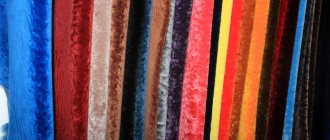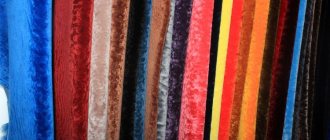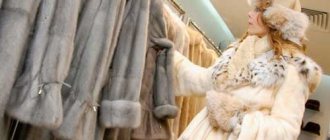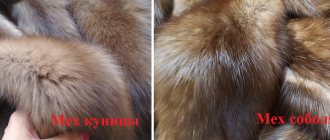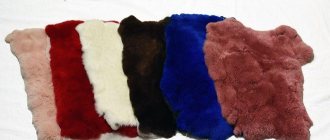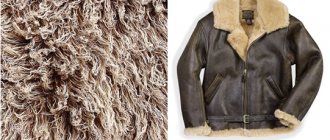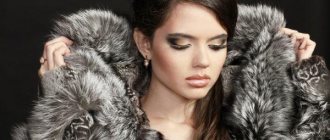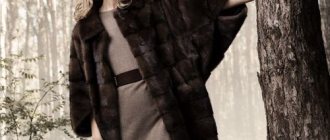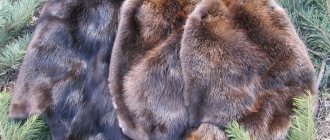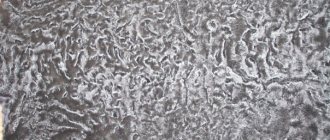Skinning a badger
Badger skins are removed in a layer with a cut in the middle of the womb and with the hair on the head and paws intact (the claws are removed). Cleared of muscle tissue and tendons; the skin is well degreased without damaging the hair roots. The skins are well straightened into shape and preserved using a fresh-dry method.
Where does the badger live?
Photo: Badger in the forest
The badger tribe is widespread throughout the Earth. The badger lives throughout almost the entire territory of Europe except northern Finland and Scandinavia, because in these regions the soil freezes too deeply. This animal also settled in Transcaucasia, in the territories of Western and Minor Asia, and in the Caucasus. The badger loves various forest areas and can settle in mountainous areas, steppe areas, and even semi-desert areas. The badger chooses places near water bodies, the main thing is that these areas are not exposed to spring floods and are always dry.
The badger’s favorite hole, in which it spends long periods of time, is a refuge and cozy home. The animal prefers to build its homes along the steep banks of rivers and lakes, on various hilly slopes.
The common badger is very consistent and conservative, so its hole can become the habitat of more than one badger family; it is passed on to the next generations by inheritance. Badger, like a noble feudal lord, passes on to his descendants his large, deep and ornate landholdings, which have been modeled and improved over the years.
In places where there is no shortage of food, different badger families can live together, connecting their burrows with underground passages. It turns out to be a whole badger hostel, which underground can extend over a large area, forming entire underground kingdoms where badgers live and rule. Such underground labyrinths have a multi-tiered structure with a large number of entrances and exits and various openings for ventilation.
In the dark corridors you can find more than one nesting chamber, which are made deep (five meters or more underground), they are very cozy, comfortable, and always covered with dry grass. These nesting areas are not accessible to water seepage. It is worth noting that there are also solitary badgers that live in ordinary small burrows.
The badger is very economical and clean; he always keeps order in his home, regularly throwing out garbage and changing the bedding for new ones. He even takes the latrine outside the territory of his burrow, or sets aside a special remote room for it. In the burrows there are other rooms necessary for housekeeping. Many people should learn to be neat and love cleanliness and comfort, like a badger.
Untreated badger skins
Although badger skins up to 60 cm long and up to 4000 cm2 in area from different regions differ in their commercial properties, they are not divided into ridges because of their cheapness, small quantity and use mainly not for fur. Among badger skins there are many rotten ones; Some of the skins are devoid of fur on the spine (spring, summer).
Based on size, raw badger skins are divided into 3 groups
The area of the skin is determined by multiplying the length (measured from the middle of the eye to the root of the tail) by the width, measured in the middle of the skin.
There is only one molt per year, it begins 1 - 1.5 months after animals awaken from hibernation in the spring and continues throughout the summer. In late autumn, the growth of new hair, which began in the second half of summer, ends, and the awn grows before the down.
Raw badger skins are divided into 3 grades
Spring skins (in the active molting stage), summer skins (almost hairless) and the skins of young animals are prohibited from being accepted. Leather is not an indicator of grade; she is thick and tough.
According to defects, there are 4 groups of defects, they depend on the area of holes, frayed places, bald spots, cowlicks, etc. Skins with slightly thinning fur are classified as a medium defect. Since badger skins are used almost entirely on the hands, tears are not considered a defect. Whirlwinds play a big role, since brushes require straight and elastic hair, but in cowlicks they are uneven and, moreover, more brittle.
Based on the coarseness of the fur (hair), badger skins can be divided into 2 groups:
- Fur - mainly Siberian badger, with lower soft and dark fur (hair).
- Carpal - with coarser fur.
The value of fur from badger skins (in %) to the cost of skins of the 1st grade
Origin of the species and description
Photo: Badger
As already mentioned, the badger is a representative of the mustelid family; it belongs to mammals from the badger genus. Mustelids or martens represent a group of predators. This family has a fairly large assortment of different species - more than fifty. So it includes: ferret, otter, mink, wolverine, marten and, naturally, badger. They adapt perfectly to different living conditions, so they are found in almost all corners of the globe.
For predators they are quite small; there are also very small ones. The length of the body varies from 11 cm (weasel) to one and a half meters (sea otter). The body is usually graceful and elongated, although there are also massive representatives (wolverine and badger).
As for badgers specifically, there are several types of them:
- Asian badger;
- Japanese badger;
- European badger (common);
- American badger.
All of them differ from each other not only in their habitat, but in the color of their fur, some habits and external features. The common badger (European) has a permanent residence permit in Russia, whose attractive appearance is well known to many.
Badger fur as a valuable product
Badger fur is used in bristle-brush and leather production. Guard hairs are used to produce expensive shaving brushes. The hair of young animals does not fit on brushes. Shaving brushes made from badger fur are durable and do not irritate the skin (pork bristles are rougher). For brushes, the spine is pulled out in the middle of the ridge (the spine on the sides is too sparse and soft). In addition to tassels, badger fur is sometimes used for ladies' collars and trims. For this purpose, softer skins are used. The awn is also used for adding gray hair to the skins of red foxes, dyed black (like a silver-black fox), and beavers without gray hair. The leather is used for haberdashery products.
Appearance and features
Photo: Animal badger
Based on the size of its family, the badger is quite large and massive. The length of its body can reach up to one meter. The tail is about 25 cm long. Males are larger than females. The badger looks awkward because its body has a cone-shaped shape, which becomes very narrow towards the muzzle, and on the other side it has a rather wide base. He looks quite well-fed and respectable, especially in the fall, when he gains fat, preparing to go into hibernation. The weight of a badger is usually about 24 kg, and before wintering it reaches 34. The badger’s head is elongated, its ears are small and round.
At the base of the tail of badgers there are anal glands, which emit a pungent and specific aroma. He helps the animals discover their fellow tribesmen and find a common language with them. Short and powerful badger paws with long claws help him dig the deepest holes, which often turn into entire underground cities. Badger molars are very strong with a flat surface, thanks to them, he can cope with any rough food, grinding it with them like millstones.
Video: Badger
On the body and tail, the badger's fur is very long, but rough and reminiscent of bristles. On the paws and in the head area it is shorter and softer. Beneath the long, coarse fur there is a warm and soft undercoat. The color of a badger's coat ranges from gray to brown; the fur often has a silvery tint. The bottom of the badger is dark, almost black. The color may vary among different species, depending on the habitat. The common badger is very beautiful and unusual with its colors.
On the white muzzle there are two wide stripes of dark color, which go from the nose to neat ears with a white edging. On these stripes are small and shiny dark badger eyes, which give the animal a sweet and good-natured appearance. In the winter months, the badger's color is lighter, and in the summer it is darker and more pronounced. The animals' molting continues all summer, and by autumn new and beautiful fur begins to grow.
Features of character and lifestyle
Photo: Badger
To match its attractive appearance, the character and disposition of the badger is quite friendly. The common badger is not at all aggressive. Having met a larger predator, or a person, he tries to leave in English, hiding in his cozy hole. The peak of badger activity occurs at night during the hunt. By itself, he is quite noisy, you can hear his loud sniffing and other funny sounds, and see his leisurely and funny gait.
Badgers are unlucky with their eyesight - it is rather weak, but their nose did not disappoint. The badger has a keen sense of smell, and hearing is also acceptable, thanks to this, it quickly navigates at night. It has already been said that the badger is quite good-natured, but if it is not possible to elude the ill-wisher right away, then he can get angry and bite him, hit him with his long nose, and only then try to make every effort to escape as quickly as possible.
It can be noted with a certain degree of confidence that the badger’s character is calm. He will never be the first to get into trouble. These animals have a very friendly disposition. The badger loves to live not alone, but with his family. They lead a fairly sedentary lifestyle, loving their hole, which they will never leave unless there are very compelling reasons. Such a shelter serves as a home for many generations, the main thing is that there is enough food and plenty of water. It is necessary to add that badgers are the only ones in the mustel family that hibernate for the winter, like real bears.
What does a badger eat?
Photo: Badger in nature
The badger is most active at night, like the vole mouse, although it can begin hunting before dark and continue at dawn. It can be called an omnivore, but it still prefers animal food. The badger loves to eat small rodents, frogs, and lizards. It does not disdain birds, eating not only them, but also eggs from nests. The badger loves to kill a worm by eating earthworms, various larvae, all kinds of bugs, mollusks, slugs, and snails.
The badger even eats some poisonous snakes; their poison is not dangerous for him, because the animal has immunity against it. If you are lucky, this predator can also drag away small bunnies, which he also likes. Plant food is also a source of food for him. He constantly snacks on berries, nuts, mushrooms, grass, pulls them out of the ground and feeds on all kinds of roots. Badgers also like to visit cultivated land located near their place of deployment. Among cultivated plants, they give their preference to corn and various legumes.
During night forays, the badger travels long distances, examining fallen tree trunks in search of its favorite worms and other insects.
He can catch up to 70 frogs and hundreds of various insects in one night. For a daily period, only 500 g of food is enough for him. When autumn approaches, he eats up, consuming much more food, so that the extra fat helps him survive winter hibernation perfectly, falling into a sweet sleep.
Natural enemies of the badger
Photo: Animal badger
The badger lives quite quietly and peacefully, so it has practically no enemies in the wild. Hungry lynxes, wolves, and rarely bears can pose a danger to the animal. He sometimes comes into confrontations with foxes and raccoon dogs. Occasionally, ordinary stray dogs can pose a threat to him.
His main enemy is man. Many badger families die when people change the natural landscape of the places where they live. Also, people can exterminate badgers because of the damage they cause to their crops, although it is not so significant. Badger fat is of great value in medicine, because of which badgers are hunted. During it, badger burrows are often destroyed, and this leads to the death of not just one animal, but often several families.
To summarize, we can list the following enemies of the badger:
- wolves;
- lynx;
- fox;
- raccoon dog;
- Brown bear;
- ordinary dog;
- Human.
